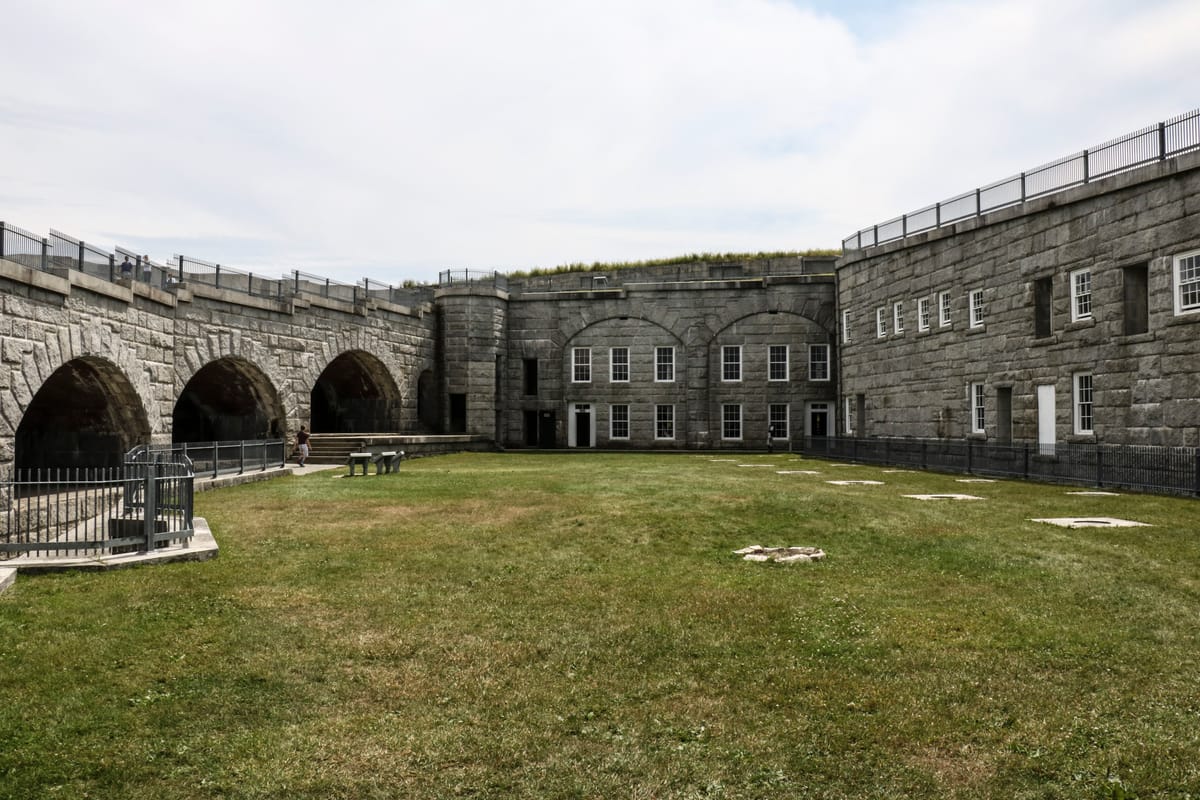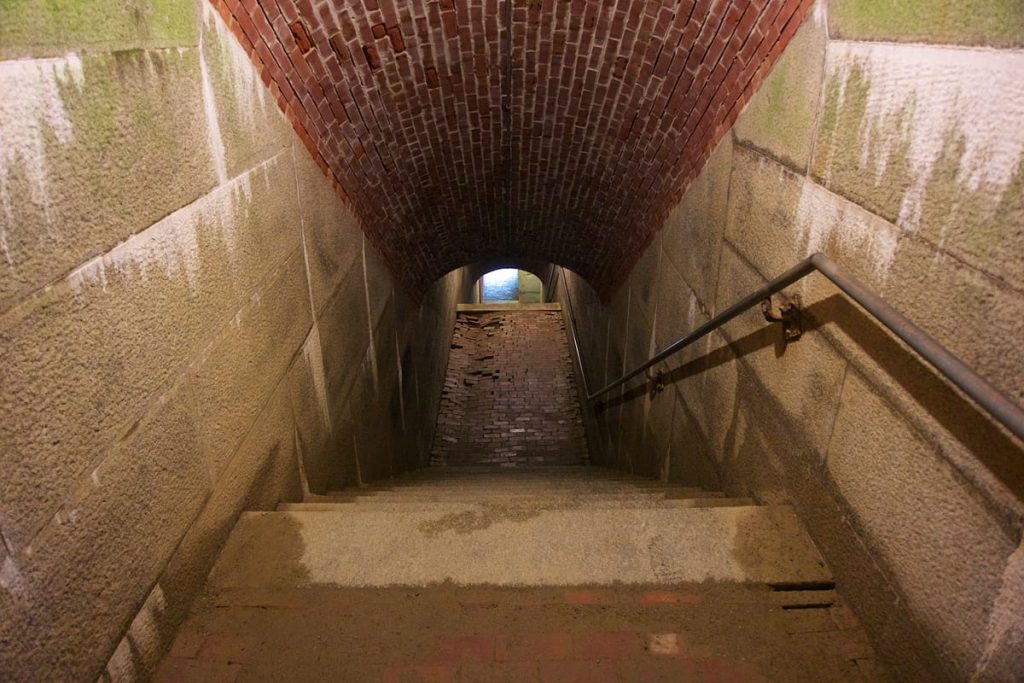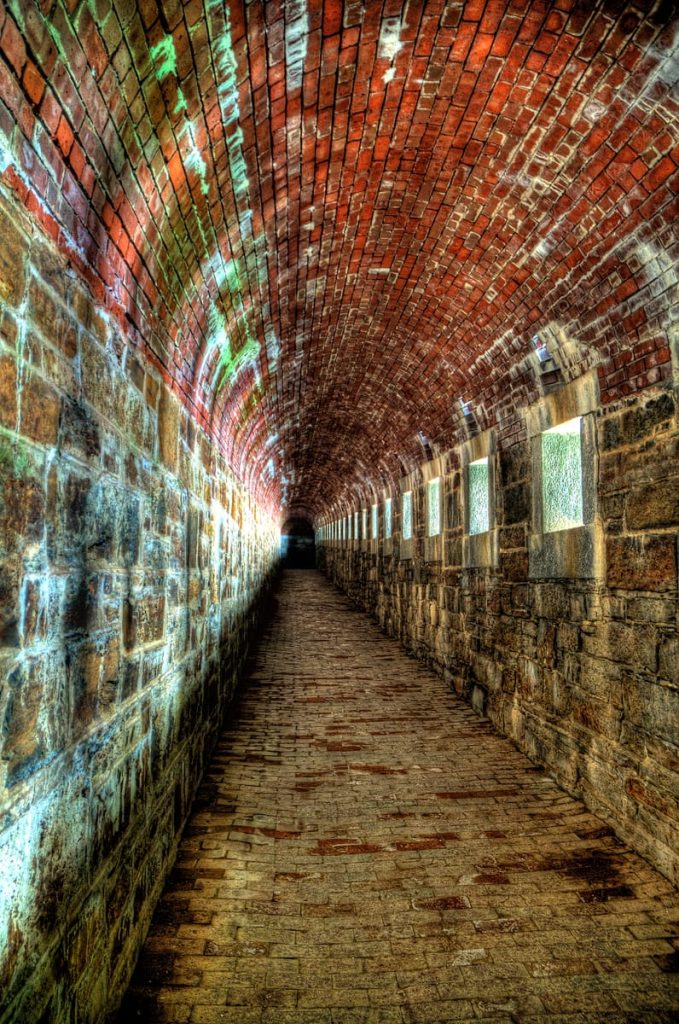
Fort Knox
Though not a fort full of gold, Maine’s Fort Knox might just be full of ghosts
Fort Knox’s Paranormal Claims
- The spirit of a former fort keeper supposedly still makes his rounds, closing and locking open doors
- The spirit of a workman who died during the fort's construction is also reportedly encountered
- The fort keeper's spirit can also be heard walking around, and his pipe tobacco can be smelled
- Visitors frequently report taps on the shoulder and tugs at hair without explanation
- The spirit of a little girl is known to walk the fort in search of her mother, though the source of this spirit remains unknown
Fort Knox’s Revolutionary History
Though we at Haunted US understand the excitement of searching for ghosts within the gold-lined vaults of the US’s bullion depository, that’s a different Fort Knox. But don’t be dispirited! Maine’s Fort Knox, now known as the Fort Knox State Historic Site, has a fortune of history and education to share with anyone who passes through its old granite walls.

From preserved cannons and casemates to original shot furnaces, Fort Knox’s past remains as frozen as the Penobscot River in winter. And, alongside that well-preserved history, stories suggest the Fort Knox State Historic Site is home to a treasure trove of paranormal activity.
Timeline of Fort Knox's History
Swipe or use timeline points to see Fort Knox through the years

1779
In the late 18th and early 19th centuries, Maine was a hotbed for anti-British sentiment. In 1779, facing the loss of the American colonies, the British claimed modern day Maine, calling it New Ireland. Massachusetts, understanding the dangers of a nearby British base, sent a naval force to remove them in the Penobscot Expedition. This expedition proved the worst US naval disaster until Pearl Harbor, costing the new nation 43 warships. But, with the Treaty of Paris in 1783, the New Ireland colony was ceded to the US regardless.

1812
When the War of 1812 came to pass a few decades later, Maine was again captured by British forces and not relinquished until the Treaty of Ghent sent their forces into modern Canada. With the humiliations faced during British occupancy still stinging in the minds of many Mainers, regional leaders spent the following years eager to establish an unstoppable fortress on the shores of Maine.

1844
Those leaders got their wish in 1844, when construction on Fort Knox began. The first fort in Maine to be built entirely of granite stone, Fort Knox promised to be miles ahead of the competition when it was finished. Unfortunately, the project’s funding proved slow-moving, and by 1869, funding for stone forts had been stopped. Regardless, Fort Knox in 1869 was a force to be reckoned with. Including 64 guns and two open water batteries, the fortress was a serious threat to any naval force hoping to take Maine.

1860
In the early 1860s, the still incomplete Fort Knox was pressed into Union Army service, though it never saw battle in the Civil War. The fort was utilized as a training ground and updated to include more advanced firepower. The Confederate Army never made it as far north as Maine, but it would’ve been difficult for them to take Fort Knox. Once funding for construction ceased, activity at the fort quieted down for several decades, with few troops being regularly stationed at the outpost.

1898
War came to the US once more in 1898, when the Spanish-American War broke out. A Connecticut infantry regiment was stationed at Fort Knox at this time, tasked with laying an underwater minefield in the nearby river. However, the minefield never saw use. After the war ended, staffing at Fort Knox was reduced to just a single ordnance sergeant, referred to as the ‘Keeper of the Fort.’ The keeper kept up with maintenance of the fortress over the following years, and later organized the fort’s use as a warehouse for naval mines.

1923
In 1923, the US declared Fort Knox to be military surplus and put the property up for sale, selling it to the state of Maine for $2,100. Though future use for the space was uncertain, the trials of the Great Depression breathed new life into Fort Knox, and the New Deal’s Civilian Conservation Corps sought to convert the fort to a tourist destination. Between the 1930s and 1943, the CCC workers added picnic spaces, roads, and fireplaces, as well as refurbished retaining walls and the fort’s interior.

1943
The renovated property began operating as a state historic site in 1943, and has greeted countless tourists in the years since then. But, after nearly 80 years as a tourist destination, Fort Knox has built up numerous ghost stories and haunted legends. And though the old fort never saw battle, many visitors and volunteers say the ghost stories at Fort Knox might just have something to them.
Fort Knox’s Paranormal Keeper
Just because Fort Knox never saw battle doesn’t mean no one died there, and at least one soldier is confirmed to have died on duty at the fort. Leopold Hegyi served as one of the first “Keepers of the Fort” in the late 19th century, and, as the sole inhabitant of the fort, he was tasked with keeping everything secure and maintained.
In July of 1900, a passing ship noticed the fort’s flag not flying, and sent for a wellness check on the keeper. Hegyi was found deathly ill in his quarters. He died at Fort Knox on July 17, 1900.






Leopold Hegyi has since become a mainstay spirit around Fort Knox, often being spotted by visitors. Many people who have reportedly encountered his spirit say that he is still making his rounds, closing and locking doors as he goes. His footsteps are often heard pounding through the open corridors, and others have reported the smell of his tobacco following the footsteps around. And, legend has it Hegyi is not the only soldier to have died at the fort.

Exploding Ghosts at Fort Knox
A much older legend, dated October, 1844, tells the story of a fort builder who let his confidence get the best of him. Part way through a hard day of labor, one of the construction workers took a cigar break while sitting on a barrel.
Little did he know, the barrel was full of gunpowder. When the workman went to stifle his cigar on the barrel, the contents ignited, killing him instantly. Ever since, workers and visitors have reported the ghost of this worker still lingering around Fort Knox.

Fort Knox’s Fickle Phantoms
Though the ghost of this unfortunate laborer is harder to pinpoint than Hegyi’s, many people report encountering him through the unique smell of his cigar, which is said to be noticeably different from Hegyi’s pipe tobacco smell.
The laborer’s phantom has also been identified by the sound of footsteps following Hegyi’s around the complex, or through the sound of mysterious, low booms. Perhaps the residual sound of the poor workman’s demise?

A Treasure of Haunts at Fort Knox
The hauntings of Fort Knox have grown to take on a life of their own over the years. Ghost tours and public investigations are common events hosted by the Friends of Fort Knox organization, and they offer numerous members of the public their own opportunity to experience the fort’s ghosts for themselves.
In recent years, the spirits of Fort Knox have gained considerable press, being featured on the Travel Channel shows Most Terrifying Places in America and Destination Fear. So, while you’re not likely to uncover a fortune in gold bars during your time at this Fort Knox, you might just find the ghosts within the fort are worth their weight in gold bullion.


